 Wednesday 24 February to Saturday 20 March 2010, Buenos Aires
Wednesday 24 February to Saturday 20 March 2010, Buenos Aires Wednesday 24 February to Saturday 20 March 2010, Buenos Aires
Wednesday 24 February to Saturday 20 March 2010, Buenos Aires
Music everywhere. In restaurants, on the streets, coming from cars, at the hotel, in the bus, in the train.
Hairstyles from long to short. Many men with ponytails. Latino good looks. Couples kissing and romance in the air.
A European city where we can, more or less, understand the language. A huge contrast to Asia. Not so cheap though.
Time spent eating, adjusting to late mornings and later evenings, soaking up the atmosphere, watching Tango dancers.
Delicious coffee and croissant for breakfast. I have definitely gone back to drinking coffee after giving it up in Asia.
Taxi drivers - the same everywhere. An old scam - you gave me the wrong denomination note! We did not fall for it.
The first time I have had my pocket picked - HORRORS. The feeling of personal violation is worse than the financial loss and the inconvenience of replacing the cards. Two weeks later Pieter had his pocket picked - just before David sent my replacements over. They only got his ATM card so we still have 1 credit card. OH THIS IS REALLY GREAT!!!!!!!!!
Unexciting museums. Except for the Evita Museum.
A kaleidoscope of impressions. The ambience is fantastic but besides soaking up the atmosphere there is little to do while we wait for the car.
La Recoleta cemetery was founded in 1820 in the gardens of a Trappist monastery. It is one of the worlds most remarkable cemeteries. The ostentation and sheer portrayal of excessive wealth is overpowering. The family mausoleums rise several meters above ground and go several meters below. They can have altars, stairs, shelves for the coffins, air vents and maintenance personnel (aka cleaners). Then again one or two are very simple, presumably the poor, hopefully the sensible. I much prefer the Buddhist idea of giving the body back to the vultures or fish. It is definitively worth seeing though. We caught the bus there and back. With one way streets everywhere we missed our stop on the way back and with Pieter's firm conviction that the route was circular we decided to stay on. The route is very long and not circular! We went through the outer suburbs, past houses with small half postage stamp sized gardens, through areas with postage stamp sized gardens and into the country before finally reaching the end. Out there some people are still using a horse and cart. Four hours later we returned to out starting point. A good way to see the non tourist areas.

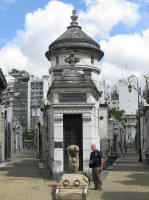
We did not use an agent to import the car but did it ourselves for a third of the cost. This means we saved over a month's living expenses. Definitely worth it. The whole process took 4 days, not full days. Half a day at the Shipping company, 2 hours for customs, half a day to start the process at the port and return to the Shipping Company to collect the delivery form they had forgotten to give us. A full day to pay port charges at a bank in the centre of town, return to the port and go through all the procedures before finally leaving with our car.
We now have a week before our replacement cards arrive.
Sunday 21 March 2010, Lujan
We didn't get very far, less than 100k. It was pouring with rain, we couldn't see much of the countryside and it was definitely not the weather to camp or visit sights. I wanted to see Lujan anyway so we booked into a nice hostel for the night right on the main square.
By late afternoon the rain had stopped and we visited the basilica. The Virgin of Lujan is the patron saint of Argentina, Paraguay and Uruguay and the patron saint of public transport. The "virgin" is a small terracotta image made in Brazil. It was brought to Argentina by a merchant. It stopped at Lujan on its way to his estancia and could not be moved. So a small chapel was built to house the virgin. This has been replaced with the neo-gothic basilica which was built between 1887 and 1937. It was interesting, the pilgrims more than anything else.
Monday 22 March 2010, Mercedes
Again not very far but this time we camped at the municipal campsite. Unfortunately the facilities were closed and anyway they smelt real bad. At least it was free. At last! It was great to put up the tent and cook our own food. There were plenty of trees to hide behind. The only problem was the lack of water. We did not put water in the tank before leaving SA so we only had a few litres with us. It was just enough. It was also strange to sleep under 2 blankets instead of just a sheet as we did in Buenos Aires.
The main draw of the town is a "pulperia", a traditional store. We enjoyed sitting in the square, went to the campsite and next morning totally forgot about it. We are so laid back at the moment and are moving at about a quarter of the pace of the last 5 years.
Tuesday 23 to Wednesday 24 March 2010, San Antonio de Areco
Another short distance. This time the camp ground had clean toilets, water and electricity. Unfortunately the showers were closed because it is out of season. We filled up on water and were glad of the electricity to run the fridge.
Wednesday was a really lovely day. It started with a tour of Taller Draghi. Juan Jose Draghi taught himself the art of being a silver smith by correspondence and eventually revived the art in Argentina. There are currently about 80 silver smiths in S A de Areco all working on gaucho articles. The articles cover the equipment for horses - reins, bit with straps, whip and stirrups, plus the gaucho equipment - belt buckle, knives and spurs. They are all very intricately decorated. The most interesting were stirrups where the foot rests on an upside down crown developed as a protest against the rule of Spain and stirrups with a holder underneath for coals to keep the feet warm in winter. The silver comes from USA and Mexico and is mixed with copper to make it more malleable.
Going to a parilla was delicious. A parilla is a restaurant where they serve bar-b-qued beef both meat and offal. Pieter had a hindquarter ( a strip of tender beef) and I had ribs. The portions are enormous and well cooked but still tender. Pieter actually managed to finish his but I left almost half. This was enough for a meal for both of us! There was live music to finish. We spent so long there that we went back to the campground rather than visit a gaucho museum. Not that this mattered as we found out the next day it was closed to renew the exhibitions.
Another quiet night waking to the sound of birdsong.
Thursday 24 to Friday 25 March, Tigre
Tigre lies on the edge of the Parana Delta The canals are lined with summer houses belonging to Portenos (people from Buenos Aires) and permanent residents. The houses range from luxurious to a handyman's nightmare, not dream. They all have a wharf. Some wharves are also the local rubbish collection point with piles of black plastic bags waiting today's collection. The public ferry we took travels to Rama Negra stopping at any small wharf as required by the passengers. I was expecting a small township. Instead Rama Negra is an island with many houses and a restaurant. Needless to say we had a long quiet lunch by the side of the canal and then returned to the wharf to catch the return ferry. Besides being the local 'road' the canals provide plenty of space for water sports such as kayaking, water skiing but strangely enough not fishing even though we saw some large fish jumping out of the water.
The trip back became quite difficult for me. A thin almost gaunt 40ish female passenger sat right opposite. She had black eye shadow, just a blob in the middle of each lid; shaved head except for the top and crown, this hair was caught in a pony tail; bright red lipstick; 2 earrings per ear. The best was the nose piercing. Christ with hands outstretched and legs dangling as if on a cross hung from the middle of her nose like a great big drip of snot. It was so hard not to stare but look past to the shore.
Saturday 26 to Tuesday 30th March 2010, Buenos Aires
Back to the waiting game. The cards arrived on Tuesday with an invalid ATM card. At least we have 1 working ATM card now and our full complement of credit cards. The waiting game begins all over again. This time we are having the new ATM card sent to a contact in Tandil. We can travel in the meantime.
Wednesday 31 March 2010, 17k west of Magdalena
What a day!
It started with excitement at the thought we were finally on our way. A visit to the supermarket came first. When we came out the car was missing!!!!! Horrors! Horrors! Guess where the new cards were, along with my passport and all our worldly possessions! It transpired that you are not allowed to park on the left hand side of streets in Buenos Aires. So our car but not the others parked on the left was impounded by the police. We were left with a note saying where the car was. Impounding cars is big business in BA. While we paid the fine and took the car at least 3 cars were brought in. The process is very efficient. It takes less than 10 minutes to sort out the payment and leave.
Of course finding the pound and returning to the supermarket to pick up our purchases took a long time because of the traffic. Then another hour to leave BA behind. At last - on the open road but not on the main route. Even so the traffic was heavy. So many people leaving BA for the coast for the Easter weekend. While we were still on the highway Pieter had to swerve to avoid a car which had missed a turnoff and was reversing - straddled between the fast and middle lane. I've seen similar in South Africa but only in the slow lane!
Route 11 is only 2 lanes so faster cars were passing slower ones all the time. Fair enough. Except when Pieter was passing a car and a car passed him on the outside while another car passed the slow car in the emergency lane. Yipes! At least there were no cars coming in the opposite direction. They would have had to go onto the grass verge.
When it was time to stop for the night we started looking for an Estancia where we might put up our tent as we had not seen any camp sites. We pulled into a drive and on the gate it read ' Reserva - Camping'. Great! First we booked in and then were told we could either go to the River Plate or another area near the gate. The river sounded good. Off we went, a kilometre down the road, a long way from the shower. We still went for a walk to the actual river to see how it was. I stopped to look at a flower and looking down saw at least 10 big fat mosquitoes on each leg! Definitely not a place to camp. Returning to the proper camping area we set up camp under the trees. It was so peaceful after the traffic noise in BA. Next morning we watched the youngsters riding around on their horses. Nice life for them.
Thursday 1 to Saturday 3 April 2010, Santa Teresita
Route 11 leaves a main route for a while before returning to it. The traffic on the main route was once again heavy and progress slow. The country side is flat with stands of trees and large herds of cattle. We did manage to find Liquid Petroleum Gas (LPG) and filled our tanks. The service stations refused to fill them with GNC used for vehicles because they said it has too much pressure and would rupture our tanks. Pieter is not convinced that we could not use it as we have been using LPG for a while. In Europe the same LPG is used to power cars. The new gas works though and that is all that really matters.
We had hoped to go about 100k down the Atlantic coast but due to the traffic and other delays we decided to stop at the first town. There is a huge campsite with good facilities. Because we are still playing the waiting game we decided to stay by the sea for a few days. The camp ground has very strict noise control as well. The weather was cold and windy which kept the mosquitoes down but made camping unpleasant. The parrots is the trees were fascinating to watch. One was building a nest but did not seem to be in any hurry to finish.
Sunday 4 to Thursday 8 April 2010, Mar del Plata
Another seaside resort but much larger. You could see the high rise buildings from far away. We went into a hotel because of the cold weather. Much more pleasant while waiting. We will not be going any further south this season. As soon as we have the card we will head north.
Some time was spent watching the Sea Lions. There is a colony of males in the fishing port. They jump out of the water, lie in the sun and have small disputes with each other. The effort involved in jumping onto the wharf is enormous. It can take several tries before they actually manage. A dog was 'defending' the wharf. It managed to prevent some sea lions from getting on, mainly because of the surprise factor. Once they were up though, they either totally ignored the dog or went for it. The dog skipped out of the way but once it had a reaction it kept on going back the the particular sea lion and barking loudly. That is until the sea lion gave up and ignored it, then it wasn't fun anymore. One great thing is the faint smell. Hardly noticeable at all, unlike a nesting colony crowded with families.
The sea food at the restaurants wasn't bad either. The town is very pleasant with a pedestrian street and quite a few older building among the high rises.
The Museo del Mar was amazing. It is a collection of 35,000 sea shells from around the world collected by Benjamin Sisterna over 60 years. There are so many variations of the shapes we often see and some new ones I had not seen before. The colours tended to be brown and white with many varied patterns. There were also red, orange, pink, yellow, an occasional green and rare blue or purple. I hadn't realised just how diverse shells could be. The Philippines seems to have the most colourful shells.
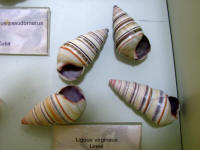
Friday 9 to Tuesday 13 April 2010, Tandil
Tandil is a lovely town set in the oldest hills in the world. The hills are not very high, only up to 500 metres. The streets in the older section are cobbled in stones from the surrounding hills.
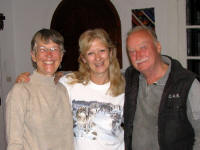 Graciela invited us for dinner on Saturday to meet some of her friends. They were all travellers and a very interesting bunch. There were lots of laughs over empanadas and tarte. Empanadas are the Argentinean equivalent of pies, except the pastry is very thin with lots of filling. Tarte is a savoury pie with the same very thin pastry. Delicious.
Graciela invited us for dinner on Saturday to meet some of her friends. They were all travellers and a very interesting bunch. There were lots of laughs over empanadas and tarte. Empanadas are the Argentinean equivalent of pies, except the pastry is very thin with lots of filling. Tarte is a savoury pie with the same very thin pastry. Delicious.
Next morning Graciela showed me how to prepare mate. This is the most common Argentinean drink and people can be seen everywhere drinking it - travelling in cars, at picnics, walking along the street. Mate is made from the leaves of a member of the holly family (Ilex paraguayensis. Hot water is available in many places to refill thermoses to top up the mate.
Then it was off to Ayacocho and an agricultural fair. What a great experience. The highlight was watching the parade where Gauchos display their horses and best clothes. After having seen some of these clothes in San Antonio de Areco it was marvellous to see it in real life. The horses are very well looked after with manes and tails trimmed neatly. The Gauchos wore their wide belts with daggers, poncho across their laps, decorated reins and fancy stirrups. Some had white boots made from horse skin - very expensive. There were also groups of horses led by a milk horse. The milk horse is led by a Gaucho and has a bell which the others follow. Very useful for leading herds across the pampas. Naturally the hoses were all matched for the parade. Families were out in typical country attire of beret and pants buttoned at the ankle.
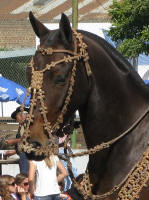
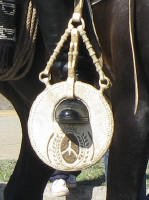
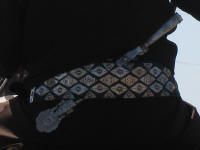
We all went for lunch at a parilla. It was very busy and the meat was not cooked as well as expected in an effort to serve everyone. Still enjoyable though. I bought a mate and straw. Mate is both the name of the drinking vessel and the herb. The straw has small holes in the bottom to prevent you from drinking the chopped leaves. Mate is my new preferred drink, along with green tea. Graciela also introduced us to Alfajores. This consists of 2 soft biscuits with a filling and sometimes a coating. The best are chocolate biscuits with Dulce de Leche filling and covered in chocolate. Dulce de Leche is sweetened milk reduced to a syrup.
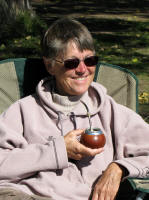
The rest of our time was spent enjoying the quiet of the lake, catching up on chores and buying CDs of Argentinean music. We will now drive to music. The attractions were all closed so there was little else to do. We did visit Epoca de Quesos, a delicatessen where you can buy local specialities such as cheeses and salamis. It is in one of the original houses in Tandil. We had cake and coffee in the garden.
Finally we found out that the card only left the Johannesburg office of EMS on Monday 12th! Another 7 to 10 days before we have it!
Wednesday 14 April 2010, Carhue
Off on another round trip to see something of the country while once again waiting for the card. We will have spent 2 months in Argentina before we are truly free to travel.
It is about 800 kilometres to Lihue Calel National Park. This is too long for 1 day of travel especially when we are only ready to leave at 11:00am. We chose to go directly west rather than take the main road. Literally directly west. A 50 degree curve requires a warning sign. This involved going on a previously tarred minor road. It was actually not too bad. The verges are very wide, enough for a 6 lane road. Naturally tracks had been made beside the old tar. Unfortunately the recent rain meant mud an water filled potholes. The car needs a wash! The first hotel we came to was at Carhue. The small towns before there did not have any hotels or restaurants, only mini mercados. Carhue is actually a resort town with spas and expensive hotels. We did find one at a reasonable price and booked in. They were prepared to provide an evening meal but only at 9:00pm, far too late for us. We ended up eating empanadas at the local service station.
The following towns all had a hotel, naturally.
Thursday 15 to Friday 16 April 2010, Lihue Calel National Park
The park is set in a group of hills rising from the surrounding plain which is covered in scrub rather than the cultivated green plains further east. The first evening our camp was visited by a grey fox. It was wary but not really afraid, obviously used to humans. Next morning Sebastian ( a young traveller who visited the park) and I drove round to the Valle de las Pinturas where there are 2,000 year old drawing on the rock. Guanaco laughed at us from the hills.
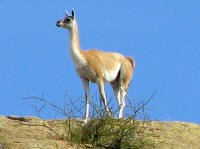

The flies were a real pest. When ever we sat to eat, clouds hovered over us and tried to join in the meal. Even sitting down without any food they still came around. Worse was the mosquitoes. I didn't think there were very many but I still managed to get thoroughly bitten. Don't they know they're supposed to sleep on cold weather?
Saturday 17 April 2010, Casa de Piedra
Time is in our favour so we decided to visit Casa de Piedra. There had been many signs along the road introducing it as a Village Touristica. Later I read that it will eventually have a casino. For now there is very little there - a large artificial lake, a free camping site with a bathroom and slightly warm showers, a shop, cabanas and a tourist office. It will be a good place for an annual holiday. There is lots to do in season both fishing and water sports, even a beach. And of course one day a casino.
Sunday 18 to Monday 19 April 2010, Santa Rosa
We managed to leave early this morning (9:30!) as we wanted to get to Santa Rosa reasonably early. We have a mountain of washing to do. There is nothing else to attract in the capital of La Pampa Province. Helados are the most prolific feature. An Helado is a shop that specialises in ice-cream, so many flavours, so little room in my tummy.
Tuesday 20 to Friday 23 April 2010, Tandil
Finally the card arrived. After 2 months in Argentina we are finally free to travel where we want!
While in Tandil Graciela showed me through the Municipal Offices where she works. It is very grand in an early 20th century style with a lovely little garden at the back. I met the Lord Mayor and greeted him Argentinean style, an air kiss to the cheek.
Saturday 24 April 2010, Rio Colarado
We didn't get very far before we had a shredded tyre. The tyres were nearing the end of their useful life but we had expected to get a few more kilometres out of them. Even so we managed a respectable 600 kilometres. In places the landscape was very much like South Africa with flat topped hills.
Sunday 25 to Monday 26 April 2010, Neuquen
There are many apple and pear orchards along the Rio Negra. They are surrounded by poplars or birch and the fruit trees are espaliered giving very thin straight rows. The colours are magnificent. The autumn yellow of the poplars and birch glowing in the sun contrasted with the red, purple and plum colours of the fruit trees. I get such a thrill seeing these vibrant autumn colours as most of my life I have not lived in areas where the trees and shrubs turn such colours.
The nearest open campsite to Neuquen was in Senilleso. A lovely basic campsite next to the Limay river. The sunset was spectacular. We have now experienced sleeping near a heard of cattle. They are never quiet, always making noises through the night.
Four new steel belted Bridgestone tyres later and we felt we were finally ready to start seriously travelling.
Tuesday 27 April 2010, Lago Barreales
Before leaving the area we went to Villa el Chocon. The museum houses the remains of the largest carnivorous dinosaur ever found, Giganotosaurus carolinii, larger than the Tyrannosaurus rex. The dinosaur was found nearby by an amateur palaeontologist named Carolin, hence the name. It was 13 meters long, 4.7 meters tall and weighed about 8 tons. There were other models and remains all well displayed. The dinosaurs found in this area are from about 120 million years ago.
There are footprints of an iguanodon and a smaller dinosaur about 3 kilometres away. We had trouble finding these as the signs were all wrong. We finally found them in a fenced off area right next to the lake.
Our next stop was a visit to an actual dig. It was too far to get to in what was left of the day so we camped off the road and over a hill near Lake Barreales. We had the morning sun to keep us warm when we got up. The colours in the rocks were amazing.
Wednesday 28 April 2010, Zapala
Pablo gave an excellent description of all aspects of the site including an explanation about how various rocks are formed by an erupting volcano. The world's most complete herbivorous dinosaur, the Futalognkosaurus dukei, has been found in the area. They have the neck, most of the spine and the pelvis. Other parts are still being found as there are many dinosaurs there. The dig is funded privately and from entrance fees. The tour is well set up to assist the guide in explaining the various stages of retrieving the fossils. The dinosaurs here are from about 90 million years ago.
Coming into Zapala we had our first sight of the Andes and snow.
Thursday 20 to Friday 30 April, 2010, Caviahue
Carviahue is very photogenic, not only the lake and the volcano but the araucaria or monkey puzzle tree, the autumn colours and the waterfalls.
Although it is only 1616 metres high there are 4.5 metre snow poles along the road. The Salto del Agrio is the best waterfall in the area. It is certainly the highest. Once again the colours of the trees, shrubs and rocks were magnificent. The Siete cascades were not as spectacular but still pretty. It would be a great walk in summer along the Arroyo Agrio to all 7 falls.
The most northern stand of the Araucaria araucana or Monkey Puzzle tree is at Carviahue. The tree is a prehistoric survivor and only grows in this region of the Andes. Young trees are pyramid shaped then gradually lose the lower branches to assume an umbrella shape. The 'leaves' are rather like the fleshy leaves of succulents and grow straight from the branches. The females produce cones with pine nuts. These are gathered and eaten. I tasted one raw so I think they are usually cooked somehow. They are rich in protein and carbohydrates.
Being relatively high and knowing from experience how cold it can be at night we decided to stay in a hotel. There are few restaurants in the town, especially at this time of year so we ate in the hotel. I know I had 'wild' rabbit as I also got the pellet that shattered its leg!
Saturday 1 May 2010, Barrancos
There was no diesel at Caviahue nor at the next town, Las Lages so we had to backtrack to Loncopue on Route 40 where we had filled up previously. We have been warned. Luckily we had an extra 20 litres on board. We now have 40 litres extra. Another problem is that banks in small towns seem to only give $300 (pesos) per transaction. This does not last very long.
The area is very dry. There are many gauchos with herds of angora goats or cattle and horses. They actually use their fancy stirrups on a day to day basis. I also saw one with horse leather boots.
At least the evenings are getting warmer.
Sunday 2 May 2010, San Raphael
We were hoping to stay a couple of nights to rest but the camp site was not very good and the showers luke warm. We did go through the Canyon del Atuel. It is very pretty. Every possible space has been utilised for tourist activities from accommodation to white water rafting and other water sports. The river was very low though, not the season for water sports. The level is controlled by a dam so no doubt they make sure there is sufficient water in summer.
Monday 3 to Thursday 6 May 2010, Mendoza
Wine country! More important a campsite with every thing except grass. They even have wifi! The weather is reasonable as well.
Besides catching up on chores we visited an Olive Farm and a winery. The Olive Farm uses canals and flooding to water the trees. The olives are delicious and we bought some.
The Trapiche Winery specialises in top quality wines. They are also experimenting with biodynamic viticulture on a small section. This entails not using any chemical fertilisers or pesticides. They have lavender nearby to attract pests and roses to give early warning of diseases which are then treated organically. The phases of the moon and movement of stars is taken into account when tending the vines. Cattle and residue from the wine making process provide the fertiliser. The number of animals required will prevent them from using this method exclusively. The vines are 3 years old and the wine is not yet commercially available. Their most expensive wine is made from Maalbeck grapes. These are hand picked from the bunch and squeezed between the fingers before processing. It is exported and costs USD 100 per bottle.
The original winery from the early 20th century was a model in its day. Some of the original vats are in the museum. The floor there has been renovated. It is made of wooden floor tiles. Originally these were laid on sand to make pushing the vats around easier. Now the work is done elsewhere.
One of the local cats adopted us for our stay. She slept very nicely on Pieter's bag every night but she was hungry. ometimes I would really like to have a pet along but the way we travel would not be suitable for it.
Friday 7 May 2010, Zonda
Another day driving. This time to San Juan where the nearest camp site is in Zonda. Zonda is in a valley in the mountains which spring straight from the plain.
The Professor Mariano Gambier Museum takes you through the history and pre-history of the region's cultures starting from 10,000 BCE. The exhibits range from stone tools to cadavers. The cadavers are exceptionally well preserved, even the eye lashes. A young man was found at 6,300 meters and is kept in a fridge. He still has flesh on his bones. He dates from around the 15th century when the Incas ruled the area. It is believed to be the southern most area of their kingdom. The basket work and weaving are beautifully done.
Saturday 8 May 2010, Villa Soto
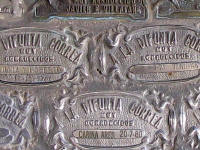 The plan is to head to Cordoba to have the fridge repaired before heading to the hot areas. The only sight on the way is Difunta Correa. The legend is that during the 1840 civil war a local man named Correa was captured, taken to La Rioja and killed. His widow headed for La Rioja to retrieve his body but died of dehydration on the way. Her infant was still suckling when she was found. The site soon became a holy place and lost travellers asked for her protection. Miraculous escapes have been attributed to her. She has become the unofficial saint of travellers especially bus and truck drivers. The shrine contains many plaques giving thanks to her and votive offerings such as photos of car wrecks from which people miraculously survived. The shrine is well maintained and surrounded by the usual souvenir stalls and restaurants. We had lunch at one. We thought we had ordered chicken, instead we were given Llama. It tastes a bit like lamb and is very tender.
The plan is to head to Cordoba to have the fridge repaired before heading to the hot areas. The only sight on the way is Difunta Correa. The legend is that during the 1840 civil war a local man named Correa was captured, taken to La Rioja and killed. His widow headed for La Rioja to retrieve his body but died of dehydration on the way. Her infant was still suckling when she was found. The site soon became a holy place and lost travellers asked for her protection. Miraculous escapes have been attributed to her. She has become the unofficial saint of travellers especially bus and truck drivers. The shrine contains many plaques giving thanks to her and votive offerings such as photos of car wrecks from which people miraculously survived. The shrine is well maintained and surrounded by the usual souvenir stalls and restaurants. We had lunch at one. We thought we had ordered chicken, instead we were given Llama. It tastes a bit like lamb and is very tender.
Sunday 9 May to Monday 17 May 2010, Cordoba
Here we are waiting again. The campsite does not have hot showers and only one electricity point, the weather is cold and the first few nights the tent dripped inside from condensation. We spent a night in the middle and at the end in a hostel to have a lovely hot shower. Most of the time was spent huddled in the car to try and keep warm. Not the most exciting thing to do.
Why? Because we are waiting for the fridge to be repaired. This seems to be what we do in Argentina - wait! The repairman is doing his best but Engel is unknown here and he has to find parts. The basic problem is electrical. It took us only 3 hours to find him. He was the fifth address we were given. Not bad in a strange city.
On the day we left he had still not repaired the fridge. The electrical fault has been fixed, now it is the compressor. We bought a dud! We have also run out of time. There is less than a week to go before our visa run out.
Tuesday 18 May 2010, Santiago del Estero
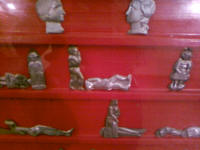 First stop was the Museo Jesuitical Nacional at Jesus Maria. It is part of a Jesuit Estancia which used to be more than 100 square kilometres - wealthy to say the least. Black slaves were used to work the winery, orchards and cattle. The most interesting section is devoted to coins from various countries. Unfortunately information on which country each coin came from is scarce in both English and Spanish. In all it is miss able.
First stop was the Museo Jesuitical Nacional at Jesus Maria. It is part of a Jesuit Estancia which used to be more than 100 square kilometres - wealthy to say the least. Black slaves were used to work the winery, orchards and cattle. The most interesting section is devoted to coins from various countries. Unfortunately information on which country each coin came from is scarce in both English and Spanish. In all it is miss able.
We need to put kilometres behind us to ensure we arrive at the border on time. Unfortunately we will miss a lot but there is always next time. The road at least was interesting. First through hills, then bush with shrubs and trees about 2 metres high and lastly swamp. There are houses on dry patches in the swamp and the land is fenced. Presumably there is a way to earn a living, goats and sheep probably.
Wednesday 19 to Saturday 22 May 2010, Salta
A full days travel through wide fertile valleys. The days are certainly getting warmer but the night?
We stayed in Salta for all our spare days to catch up etc etc. In a hostel because we really want some comfort. One thing for certain, we want to return to this area.
Apart from catching up I visited the MAAM Museum. This is dedicated to the 3 mummies found on the Llullailaco Volcano (6730m). The climate kept the mummies and their sacred objects almost perfectly preserved. Archaeological expeditions are made to the tops of such mountains because the Incas venerated high mountains as protectors of the community and made sacrifices there. The mummies were 6, 7 and 15 year old Incas from the elite class sacrificed in the 15th century. Their families believed that the sacrificed children would unite with their ancestors and watch over the community. Sacrificed lives were rewarded with health and prosperity. Presumably they did not suffer much as they were given beer to make them fall asleep and then placed in holes with a rich trove of sacred items. Hopefully they would have frozen to death before they woke up.
A visit to the top of San Bernado Hill was good exercise as I walked down (one hour) after ascending by cable car. There is an artificial waterfall at the top which the locals are proud of. The pathway up/down has the 12 stations of the cross which give an indication of how far you still have to go.
Sunday 23 May 2010, La Quiaca
I thought the trip to the border might take 2 days based on the write up on the scenery. We did it easily in 1 day. The road starts by following a river through the hills. It is quite narrow but beautifully shaded by trees. From San Salvador de Jujuy it follows the Humhuaca Valley. This is noted for the colours of the rocks which were spectacular in places. We stopped at Tilcara for lunch. There was a market in the main square where Pieter bought a felt hat and I bought a piece of cloth. This turned out to be Bolivian in design, very bright. A great scenic trip.
| Averages | USD | Back to South Africa | Next Bolivia | ||
| Cost of diesel per litre | 0.89 | ||||
| Camping per night |
4.21 |
||||
| Hotels per night | 16.39 | ||||
| Total | |||||
| Kilometers traveled | 8 922 | ||||
| Days in country | 89 |